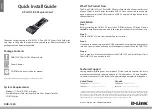
Configuring WAN Load Balancing
106
Nokia IP60 Security Appliance User Guide
DSL port (on ADSL models)
Serial port (for use with an RS232 modem)
DMZ/WAN2 port
USB ports (for use with a USB modem)
You can assign the secondary connection to use any of the above ports that is not being used by the primary
connection.
Note:
You can configure different DNS servers for the primary and secondary
connections. The IP60 appliance acts as a DNS relay and routes requests from
computers within the network to the appropriate DNS server for the active Internet
connection.
Configuring WAN Load Balancing
If your network is prone to congestion, for example in large offices which include multiple active clients
and/or servers, you can increase the amount of available bandwidth by configuring WAN load balancing.
By default, the IP60 appliance routes all traffic to the primary Internet connection, and the secondary
Internet connection is used only when the primary connection is down, or when a routing rule specifically
states that traffic should be sent through the secondary connection. WAN load balancing automatically
distributes traffic between the primary and secondary connections, allowing you to use both connections in
parallel.
When one IP address sends packets to another IP address, the IP60 appliance examines each Internet
connection's recent bandwidth utilization in kilobits per second to determine its load. The IP60 appliance
then enters the source-destination pair in a load balancing table and specifies the least-loaded Internet
connection as the connection to use for traffic between this pair. To prevent disruption of stateful protocols,
the IP60 appliance will route
all
traffic between this pair to the specified Internet connection, so long as the
pair remains in the load balancing table.
Note:
By default, a source-destination pair is removed from the load balancing table
after 1 hour of inactivity. You can change the default value via the CLI. For
information, refer to the
Nokia IP60 CLI Guide
.
Note:
In order for WAN load balancing to be effective, there must be more than one
active source-destination pair.
By default, the load distribution between Internet connections is symmetric; however, you can configure
non-symmetric load balancing by assigning a different load balancing weight to each Internet connection.
For example, if you assign the primary connection a weight of 100, and you assign the secondary
connection a weight of 50, the IP60 appliance will only route traffic to the secondary connection if the
primary connection's current load is more than twice the secondary connection's current load. Therefore, to
ensure full utilization of both Internet connections, the ratio between the connections' load balancing
weights should reflect the ratio between the connections' bandwidths.
Содержание IP60 - Security Appliance
Страница 1: ...Part No N450000643 Rev 001 Published February 2008 Nokia IP60 Security Appliance User Guide ...
Страница 4: ...4 Nokia IP60 Security Appliance User Guide ...
Страница 10: ......
Страница 12: ......
Страница 38: ......
Страница 58: ......
Страница 108: ......
Страница 268: ......
Страница 482: ......















































